The Limousin region of France is an important area for bird watching. With its diverse mix of landscapes, ranging from lush meadows and woodlands to rugged hills and valleys, the area is home to a variety of species.
From the majestic Golden Eagle to the tiny Wren, the Limousin is a veritable paradise for avian enthusiasts. Whether you’re looking to observe a rare species or just enjoy the beauty of the region’s birds, the Limousin has something to offer.
In this guide, we will explore some of the most popular birds of Limousin and uncover the secrets of their habitats and behaviour. Join us as we journey through this unique region and discover the wonderful birds of Limousin!
1. Common Cuckoo
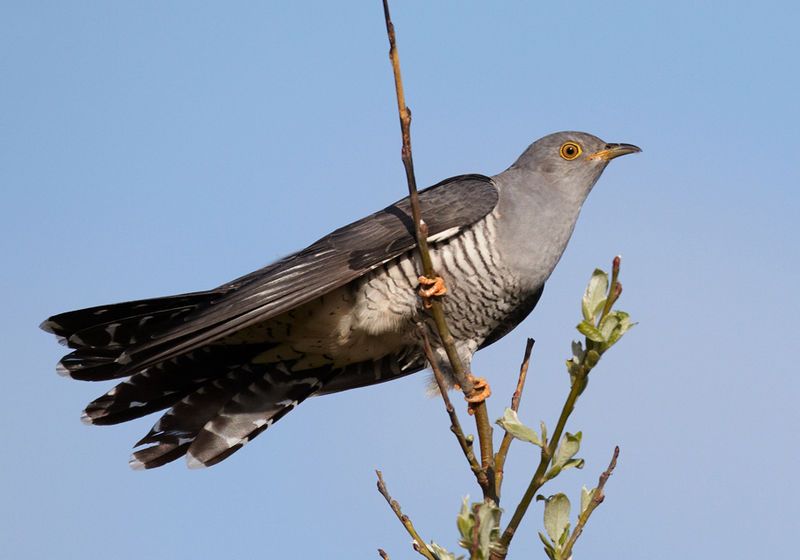
The common cuckoo is a type of bird belonging to the Cuculiformes order, which is a group of birds that includes other species such as roadrunners, anis, and coucals.
The common cuckoo is found all around the world, but they are most commonly seen in Europe and Asia during the summer months. During the winter months, they migrate to Africa where they spend the colder season.
This species is known to be one of the most widespread summer migrants in the world. The common cuckoo is a fascinating species of bird. It is known for its unique call, which is why it has been the subject of many stories and folklore.
It is also known for its habit of laying its eggs in the nests of other species, a behavior called brood parasitism. This means that the cuckoo does not have to invest energy in raising its own young, as the host species will raise them instead.
This behavior has adapted over time to help the species survive and thrive in its environment.
| Kingdom | Animalia |
| Phylum | Chordata |
| Class | Aves |
| Order | Cuculiformes |
| Family | Cuculidae |
| Genus | Cuculus |
| Species | C. canorus |
2. Common Quail
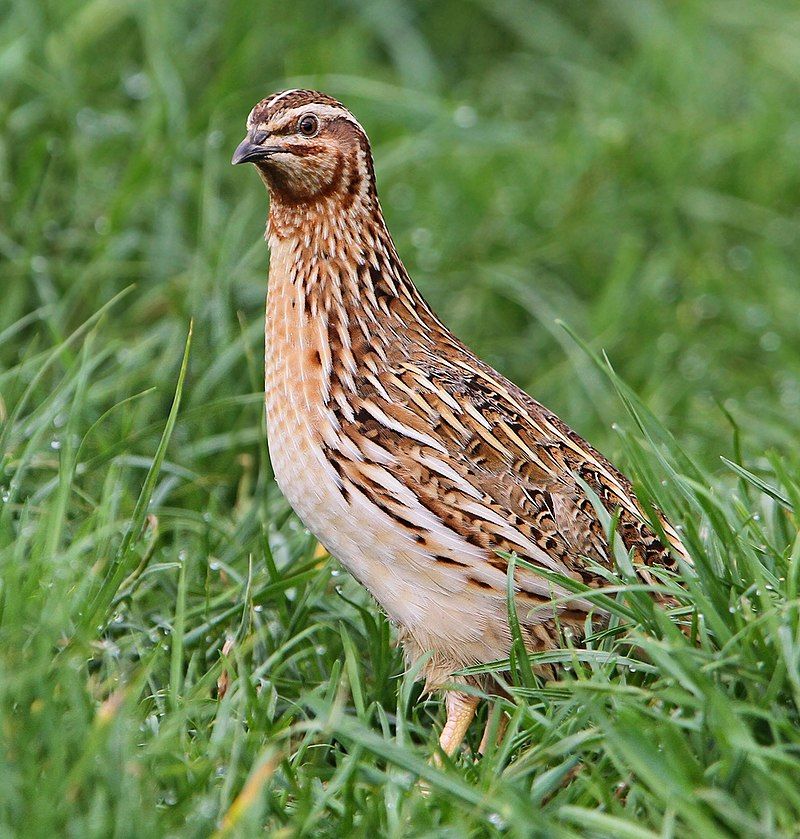
The common quail, also known as the European quail, is a species of game bird belonging to the pheasant family, Phasianidae. It is a relatively small bird, usually found nesting on the ground.
This species of quail is known for its migratory habits, breeding in the western Palearctic region in the summer and wintering in tropical areas such as Africa and southern India. The common quail is a shy and elusive bird, and it is often heard before it is seen.
Its characteristic call is a series of three repeated chirps, making it quite distinctive.
The call of the common quail is quite a unique sound, and it has been known to be used in various forms of music and poetry. The common quail is a popular game bird, and it is hunted by both recreational and professional hunters.
The species is an important source of food for many people, and its meat can be cooked in a variety of ways.
The common quail is also an important part of the ecosystem, providing prey for various predators such as foxes, hawks, and owls. In addition to its importance to humans and its ecosystem, the common quail is also a source of beauty and fascination for many.
With its muted colors and characteristic call, it is an interesting and alluring species to observe in its natural environment.
| Kingdom | Animalia |
| Phylum | Chordata |
| Class | Aves |
| Order | Galliformes |
| Family | Phasianidae |
| Genus | Coturnix |
| Species | C. coturnix |
3. Great-Crested Grebe
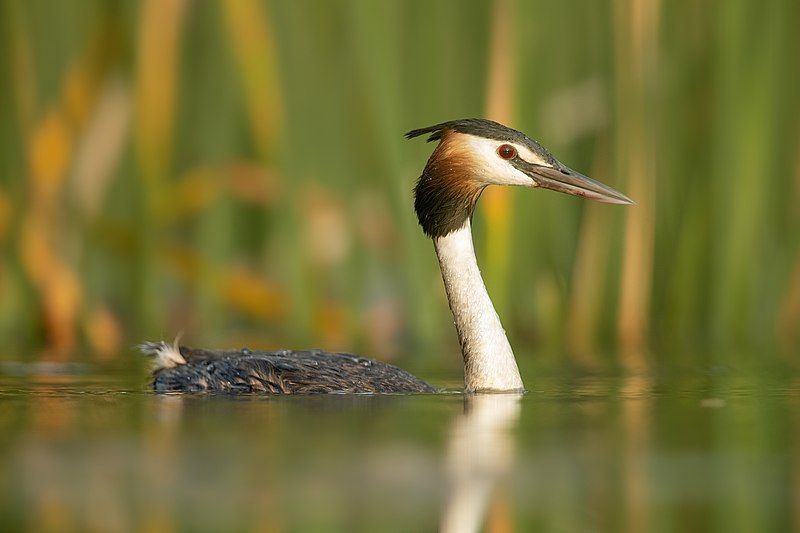
The great crested grebe is a type of waterfowl that belongs to the grebe family. They are native to many parts of the world, including Europe, Asia, and parts of Africa. They are a fairly large species of waterbird, reaching up to about 17 inches in length.
They are usually seen alone or in pairs, and they prefer to live in shallow fresh, or brackish waters. One of the most distinctive characteristics of the great crested grebe is its elaborate mating display.
During the courtship process, the grebes perform a ritualistic dance that involves plenty of wings flapping and head shaking. The male and female will also synchronize their movements, often swimming in circles while intertwining their necks.
Once the courtship is successful, they will create a floating nest among the vegetation in the water, which the female will use to incubate the eggs. The great crested grebe is an important species in many ecosystems, as they help to control aquatic insect populations and provide food for larger animals.
They are also a popular species for birdwatchers, as they are relatively easy to spot in their natural habitats and their courtship displays are quite captivating.
| Kingdom | Animalia |
| Phylum | Chordata |
| Class | Aves |
| Order | Podicipediformes |
| Family | Podicipedidae |
| Genus | Podiceps |
| Species | P. cristatus |
4. Great Egret
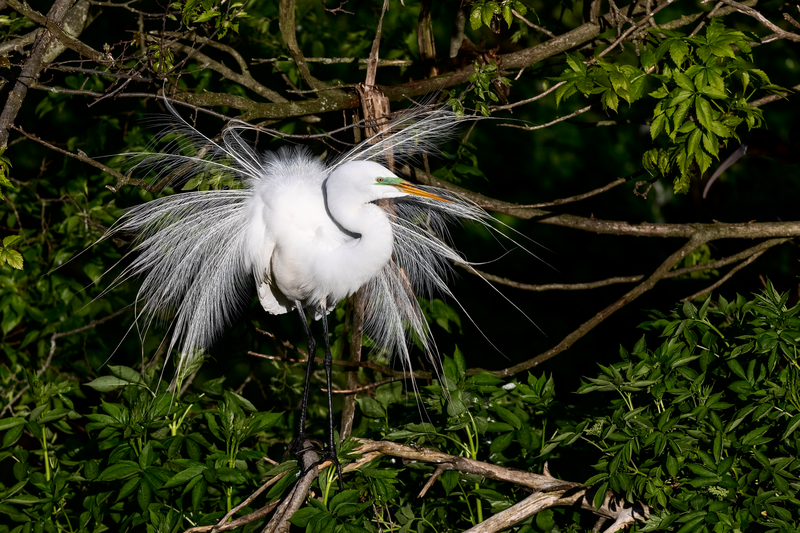
The great egret is a large, widely distributed bird species that has four different subspecies. It is commonly known by a variety of names, such as the common egret, large egret, great white egret, and great white heron.
It is native to Asia, Africa, the Americas, and southern Europe, and is now beginning to spread to more northern parts of Europe. The great egret is a majestic bird with a long, slender neck and long legs. Its body is largely white, with some parts having a yellowish tinge.
Its wingspan can reach up to five feet and its head has a distinctive crest. The large white wings are a main feature of the bird, and it uses them to soar gracefully over bodies of water. The great egret is an impressive hunter, preying on small fish, amphibians, and insects.
It hunts by slowly stalking its prey near the water’s surface, using its long neck and bill to spear its target. The bird has a variety of vocalizations, including harsh croaks and whistles.
The great egret is a popular bird for bird watchers, as it is relatively easy to spot in its native habitats. Its wide distribution also makes it a favorite among birders, who can find the bird in tropical and subtropical areas.
Conservation efforts have helped to protect the species, and its population is now considered to be stable.
| Kingdom | Animalia |
| Phylum | Chordata |
| Class | Aves |
| Order | Pelecaniformes |
| Family | Ardeidae |
| Genus | Ardea |
| Species | A. alba |
5. European Turtle Dove
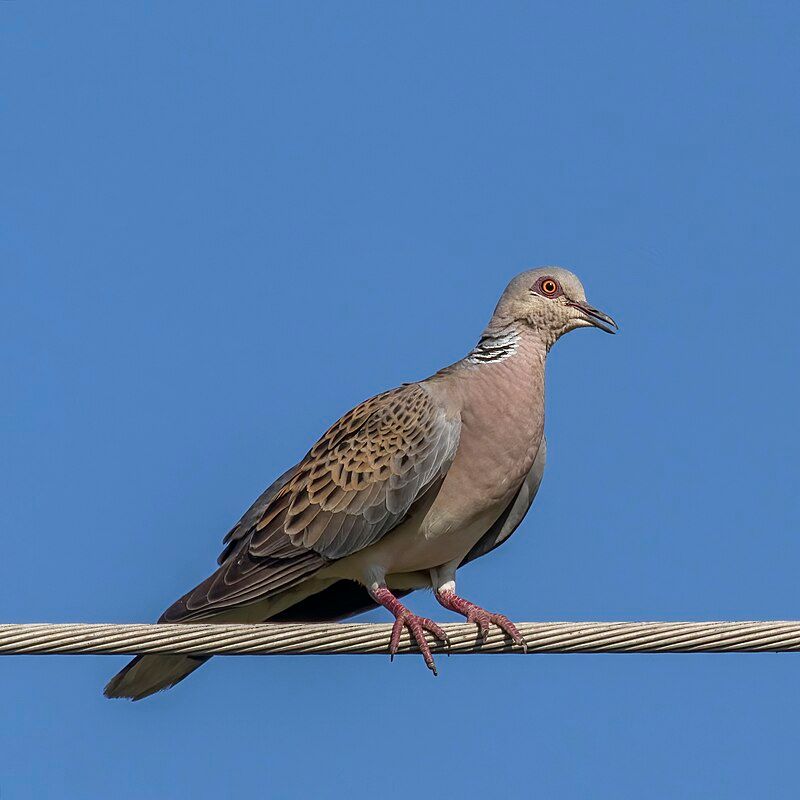
The European turtle dove is a species of bird belonging to the Columbidae family, which is commonly known as doves and pigeons. This species of dove breeds in a wide area of the south western Palearctic, which includes north African regions.
During the winter season, they migrate to northern sub-Saharan Africa for the cold months. These turtles doves are a rather unique species of bird. They have an interesting migration pattern in which they travel from the south western Palearctic to northern sub-Saharan Africa.
This is because the south western Palearctic is not suitable for them to survive during the winter months due to the cold temperatures.
They need a warmer climate to survive and the northern sub-Saharan Africa is perfect for this. The European turtle dove is a beautiful bird with its distinct black and white feathers. Its wingspan can reach up to 20 inches and its body can reach up to 11 inches.
This species of bird is also known for its melodic song which it uses to attract mates and defend its territory. Their diet consists mainly of seeds and grains. They are also known to eat insects and fruits.
They usually feed on the ground but can also feed from trees. The European turtle dove is an important species of bird and is protected by the EU Birds Directive. This directive is in place to help preserve this species of bird from becoming extinct.
It is also listed as a species of Least Concern by the IUCN Red List of Threatened Species. This is because there are still many of these birds in the wild and their population is stable.
| Kingdom | Animalia |
| Phylum | Chordata |
| Class | Aves |
| Order | Columbiformes |
| Family | Columbidae |
| Genus | Streptopelia |
| Species | S. turtur |
6. Common Crane
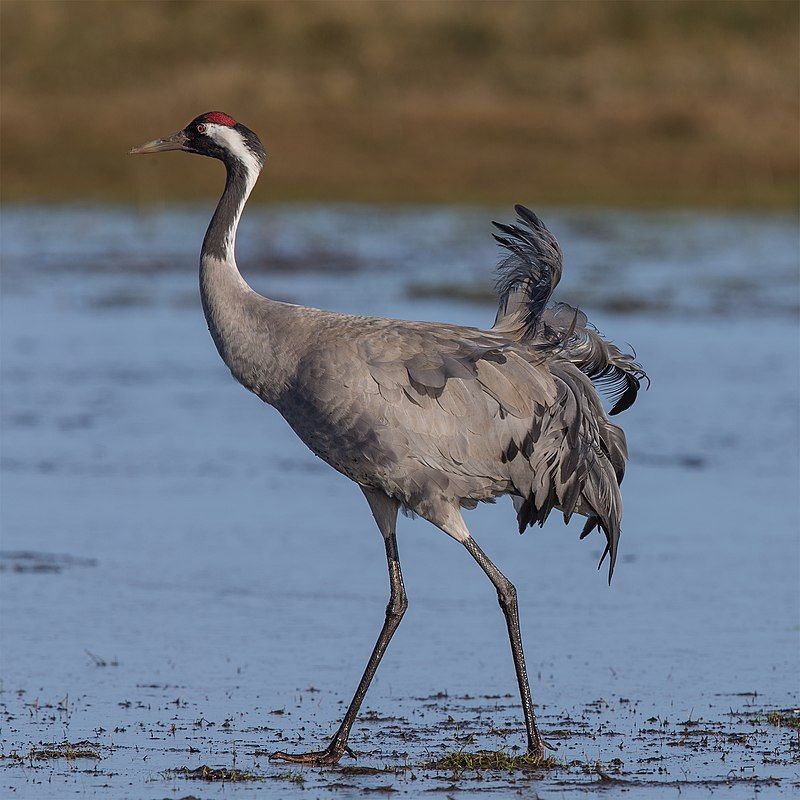
The common crane, also known as the Eurasian crane, is a species of bird belonging to the family Gruidae, commonly referred to as cranes. It is a medium-sized species, with a wingspan that can reach up to 6ft.
It is the only crane species that can be found throughout Europe, with the exception of the demoiselle crane and the Siberian crane, which are only seen in the far eastern regions of the continent. The common crane has a distinctive appearance, with a gray body, white crown, and black legs.
It is also known for its loud, trumpeting call, which can be heard up to two miles away. It inhabits a variety of habitats, including wetlands, grasslands, and agricultural areas.
Its diet consists mainly of small insects, worms, and other invertebrates, but it will also eat grains and seeds. Common cranes are monogamous, forming lifelong bonds with their mates. They are also highly social birds, often seen in large flocks.
Breeding usually takes place in the spring, with the female laying two to three eggs in a large nest built on the ground.
The chicks are born precocial, meaning they are capable of moving around and feeding themselves shortly after hatching. The common crane is listed as a species of least concern by the International Union for Conservation of Nature (IUCN).
Despite its wide distribution and large population, its numbers have been steadily declining due to habitat loss and degradation. Conservation efforts are underway to ensure the species’ survival in the future.
| Kingdom | Animalia |
| Phylum | Chordata |
| Class | Aves |
| Order | Gruiformes |
| Family | Gruidae |
| Genus | Grus |
| Species | G. grus |
7. Common Pochard
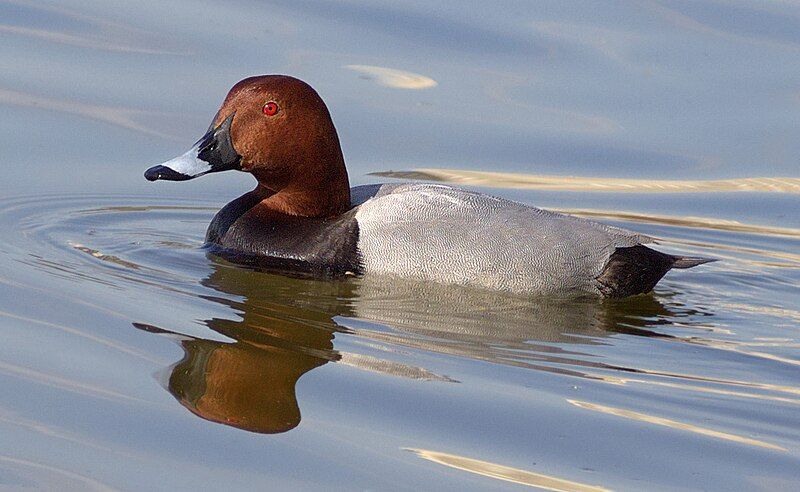
The common pochard is a medium-sized diving duck that belongs to the family of Anatidae. It can be found in a variety of habitats, ranging from freshwater lakes and rivers to coastal wetlands. Its scientific name, Aythya ferina, is derived from two sources.
The first part, Aythya, is derived from the Greek word aithuia, which was an unidentified seabird described by authors such as Hesychius and Aristotle.
The second part of the name, ferina, is derived from the Latin word ferina, meaning ‘wild game’, and is derived from the Latin word ferus, which means ‘wild’. This scientific name is thus reflective of the common pochard’s wild nature.
| Kingdom | Animalia |
| Phylum | Chordata |
| Class | Aves |
| Order | Anseriformes |
| Family | Anatidae |
| Genus | Aythya |
| Species | A. ferina |
8. Common Shelduck
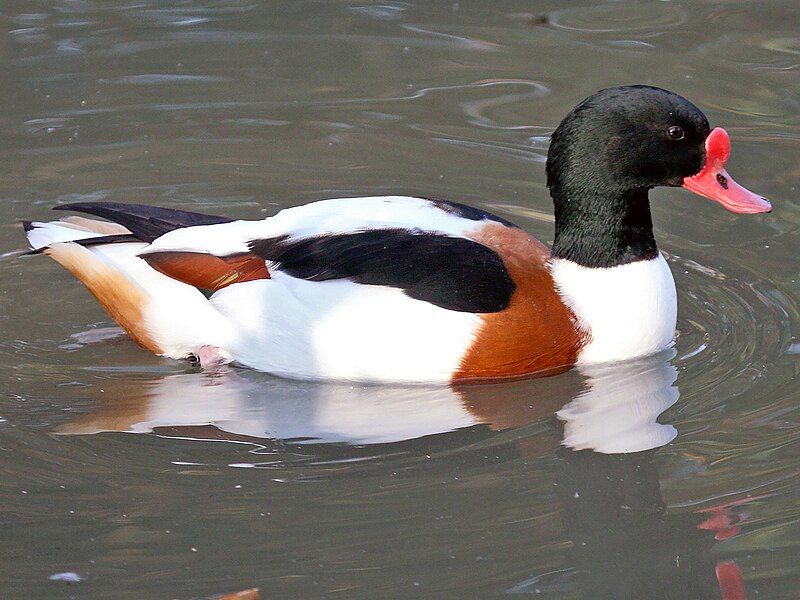
The common shelduck is a species of waterfowl found in the Euro-Siberian region of the Palearctic. It belongs to the shelduck genus, Tadorna, and is widespread and abundant across its range.
This species nests in temperate regions during the breeding season and migrates to subtropical regions for the winter. During the winter months, some common shelducks can also be found in the Maghreb.
This species is a large, gregarious duck with a striking plumage, and is often found in large flocks. It feeds on a variety of aquatic plants and invertebrates, which it obtains from both the water and nearby land.
The common shelduck is an important species in wetlands and estuaries, where it provides important ecosystem services such as nutrient cycling and pest control.
| Kingdom | Animalia |
| Phylum | Chordata |
| Class | Aves |
| Order | Anseriformes |
| Family | Anatidae |
| Genus | Tadorna |
| Species | T. tadorna |
9. Red-Legged Partridge
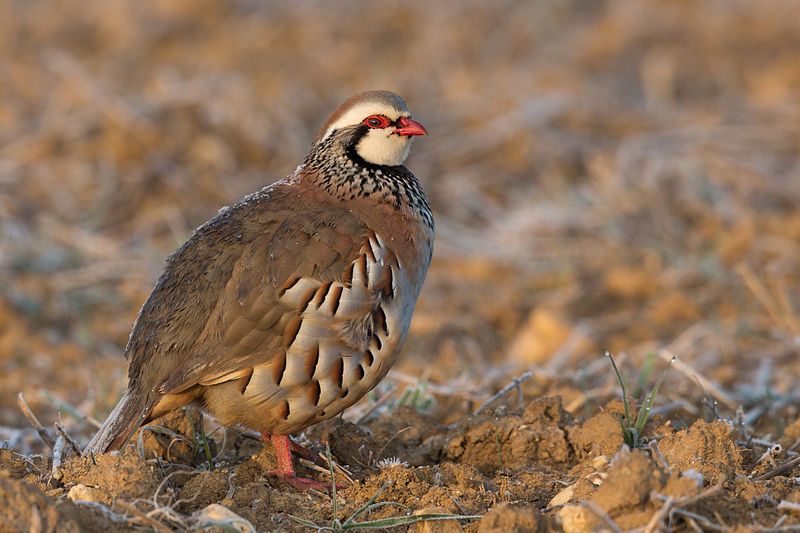
The red-legged partridge is an upland gamebird native to Western Europe. It belongs to the family Phasianidae, which includes all the pheasants, grouse, quail, and other similar birds.
This family is part of the order Galliformes, which is a group of land-dwelling birds, also known as gallinaceous birds. The red-legged partridge is sometimes referred to as the French partridge, to distinguish it from the English or grey partridge.
This is because the red-legged partridge is more commonly found in continental Europe, while the English partridge is more commonly found in the British Isles. The two species have many similarities, but some key differences.
The red-legged partridge is larger than the English partridge and has a distinctive red patch on its lower legs. Its plumage is also generally darker than the English partridge, and its breast and belly are more heavily barred.
| Kingdom | Animalia |
| Phylum | Chordata |
| Class | Aves |
| Order | Galliformes |
| Family | Phasianidae |
| Genus | Alectoris |
| Species | A. rufa |
10. Barnacle Goose
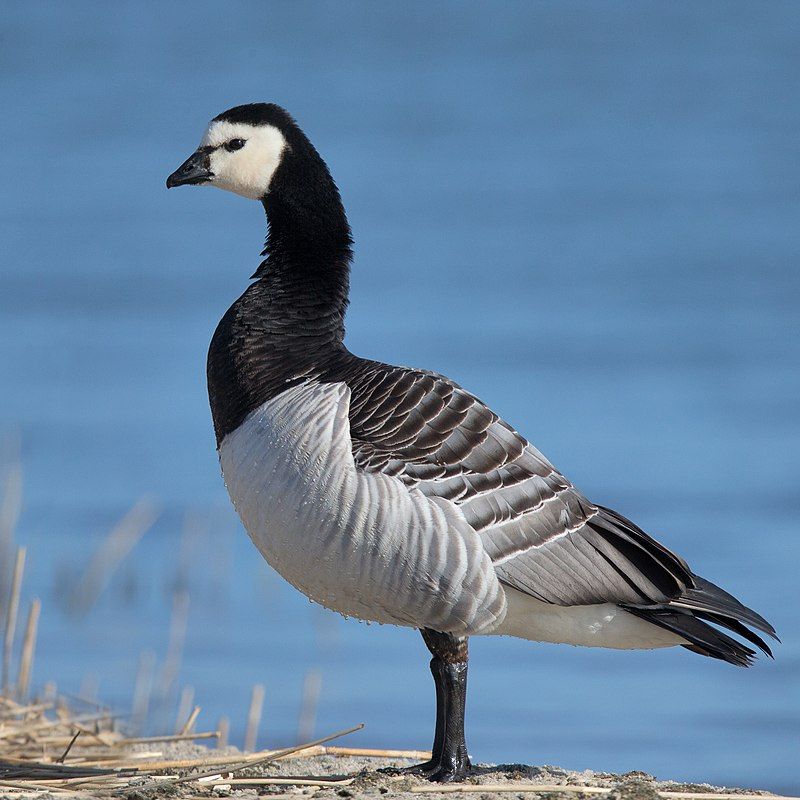
The barnacle goose is a species of goose from the Branta genus of black geese. This genus of black geese is known for its largely black plumage, which makes them distinct from the grey geese from the Anser species.
This black plumage is what helps to identify the barnacle goose and set it apart from other species of geese. The barnacle goose is also characterized by its smaller size, being the smallest goose in the Branta genus.
It has a shorter bill and shorter neck than other geese, and its wings are also shorter than many other species. The barnacle goose also has a distinctive call, which is a honking noise that can be heard from a distance.
The barnacle goose is known to inhabit areas that have plenty of vegetation, such as wetlands and coastal areas. It can also be found in Europe, Asia, and North America. The species feeds on a variety of items, such as aquatic plants, grains, and insects.
The species is also known to migrate in the winter, which can take it to various locations in search of food. The barnacle goose is an important species to the conservation efforts of many countries.
It is listed as a species of least concern, which means that there is no immediate threat to its existence. Nonetheless, the species is still monitored and protected.
It is important to ensure that the barnacle goose is able to thrive in its natural environment, as it plays an important role in the ecosystem.
| Kingdom | Animalia |
| Phylum | Chordata |
| Class | Aves |
| Order | Anseriformes |
| Family | Anatidae |
| Genus | Branta |
| Species | B. leucopsis |
11. Egyptian Goose
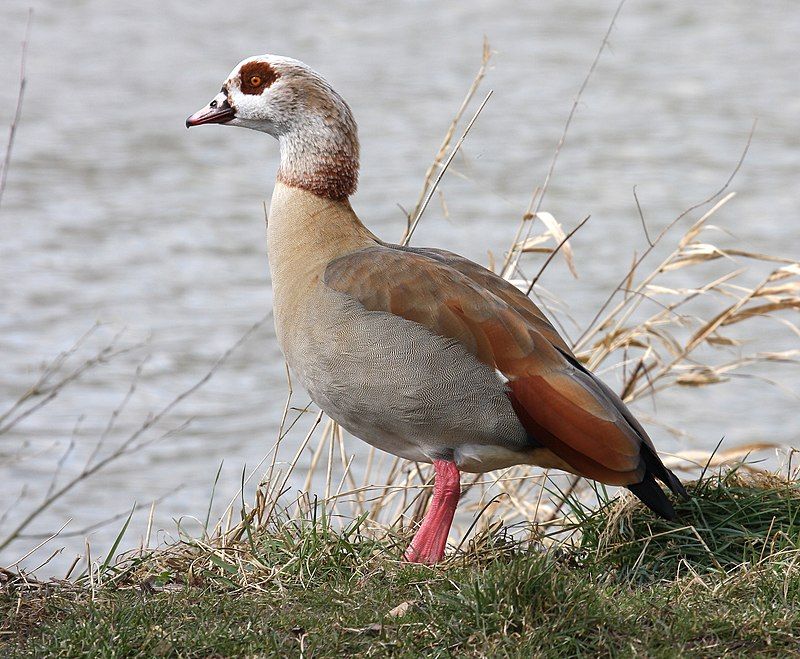
The Egyptian goose is a species of bird native to Africa that belongs to the Anatidae family, which includes ducks and geese.
This species has become popular among people who keep them as ornamental birds, leading to their introduction to places outside of their natural range, such as Europe, the United States, and other locations around the globe.
The Egyptian goose is an adaptable species, and it can easily adjust to different environments, making it a prime subject for introduction into new places.
As a result, it can be found in areas where it was not historically present, and it has become one of the most widely distributed species of Anatidae in the world.
| Kingdom | Animalia |
| Phylum | Chordata |
| Class | Aves |
| Order | Anseriformes |
| Family | Anatidae |
| Genus | Alopochen |
| Species | A. aegyptiaca |
12. Ferruginous Duck
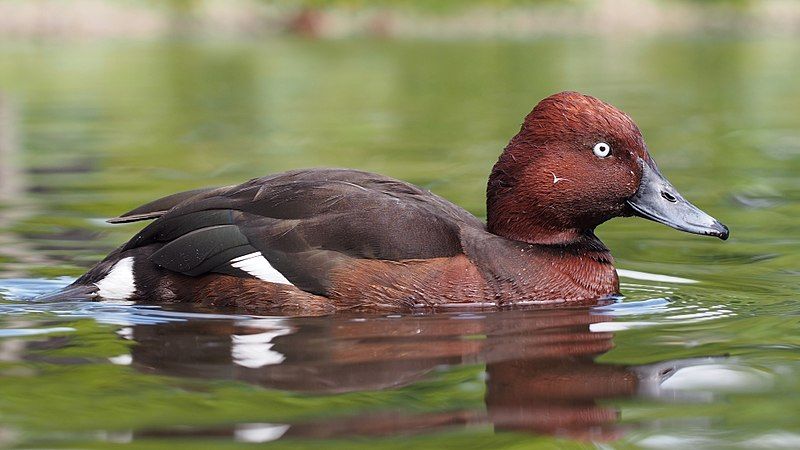
The ferruginous duck is a type of duck that is found across Eurosiberia. It has several nicknames, such as ferruginous pochard, common white-eye, and white-eyed pochard. It is a medium-sized diving duck, meaning that it prefers to hunt and forage in waters.
Its scientific name, Aythya nyroca, is derived from Greek and Russian words. The Greek word, aithuia, is an unidentified seabird mentioned by authors including Hesychius and Aristotle. The Russian word, nyrok, is the word used for a duck.
The ferruginous duck is an important species due to its role in the food chain. Its diet consists of small fish, aquatic plants, and insects. In turn, they are prey to other predators such as owls, hawks, and foxes.
As a result, they play an important role in maintaining the balance of the ecosystem. The ferruginous duck is also an important species to humans. It is hunted for its feathers, meat, and eggs, which are used in traditional dishes.
It is also an important part of the culture in some areas, as it is believed to bring luck and prosperity. In addition, its feathers are used in traditional garments and accessories.
Overall, the ferruginous duck is an important species that plays an important role in both the environment and human culture. It is a species to be respected and protected so that it can continue to thrive in its natural habitat.
| Kingdom | Animalia |
| Phylum | Chordata |
| Class | Aves |
| Order | Anseriformes |
| Family | Anatidae |
| Genus | Aythya |
| Species | A. nyroca |
13. Garganey
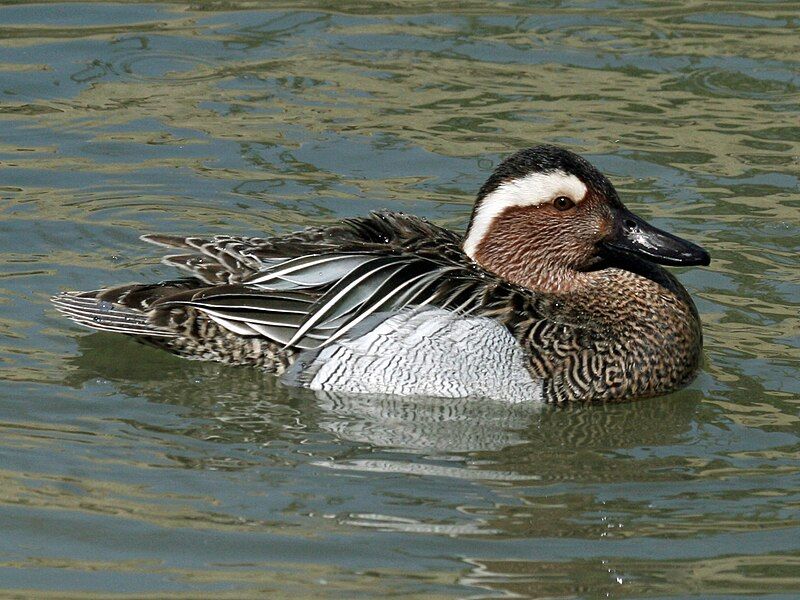
The garganey is a small dabbling duck that is native to much of Europe and the Palearctic region. During the Northern Hemisphere winter, the entire population migrates to more southern regions such as Africa, India, Bangladesh and Australasia.
These winter trips allow the garganey to flock together in large numbers, allowing them to better find food and resources. The garganey is an adaptable species, as it can breed in a wide range of climates and habitats.
It prefers shallow freshwater wetlands with dense vegetation, but can also be found in estuaries, coastal lagoons, and even flooded fields.
In addition, the garganey is highly migratory, meaning that it moves from one region to another in search of food or suitable breeding grounds. The garganey is an important species, both economically and ecologically.
As a food source, it provides an important source of protein for humans and other animals. In addition, the garganey is an important link in the food web, as it plays an integral role in the survival of many other organisms.
The populations of other species can be affected if the garganey population is disrupted. Overall, the garganey is an important species that needs to be protected.
It is essential to maintain healthy migratory populations, in order to ensure that the garganey can continue to play an important role in the global ecosystem.
| Kingdom | Animalia |
| Phylum | Chordata |
| Class | Aves |
| Order | Anseriformes |
| Family | Anatidae |
| Genus | Spatula |
| Species | S. querquedula |
14. Red-Breasted Merganser
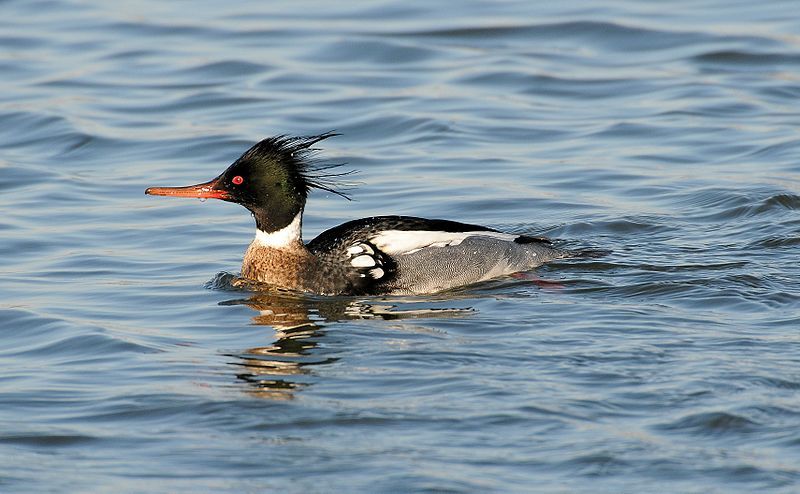
The red-breasted merganser is a species of duck that is found in many parts of the Northern Hemisphere. It is easily identified by its signature red breast, which gives the species its common name.
This distinctive red breast is only displayed by males in breeding plumage and is a sign of sexual maturity. The red-breasted merganser is a relatively large duck, measuring between 20 and 28 inches in length and weighing between 1.2 and 3.1 pounds.
The males are larger than the females and have a stunningly glossy green-black head. They also have a long, pointed beak with a red base and a red eye-ring. The females are mostly brown in color, with a white spot on the throat and a light-colored bill.
Both sexes have a white breast and belly, with the males having a distinct red breast. The red-breasted merganser is usually found near the shorelines of lakes, rivers, and ponds, as well as in areas of open water.
They feed mainly on small fish, insects, and crustaceans, and can be seen diving underwater to catch their prey. These ducks are also very proficient in flying and are capable of migrating large distances.
| Kingdom | Animalia |
| Phylum | Chordata |
| Class | Aves |
| Order | Anseriformes |
| Family | Anatidae |
| Genus | Mergus |
| Species | M. serrator |
15. Red-Crested Pochard
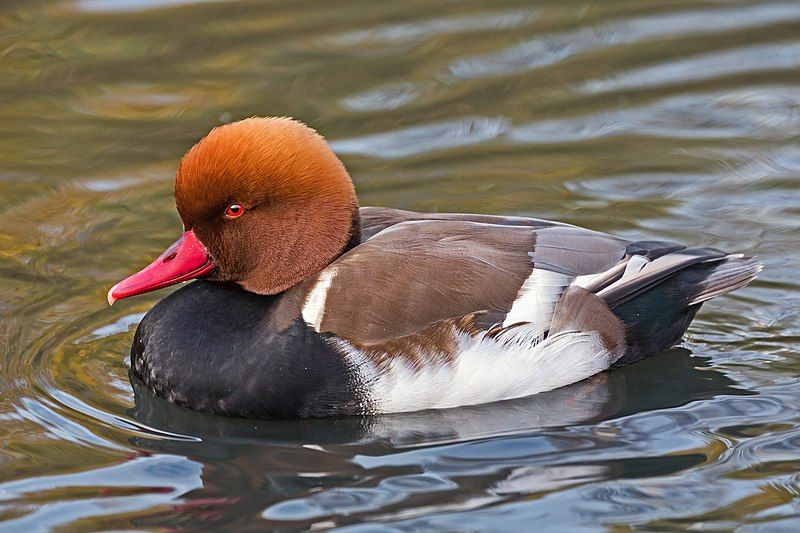
The red-crested pochard is a large diving duck native to Europe, Asia, and Africa. It is a species of waterfowl that is typically found in freshwater habitats, such as ponds, marshes, and lakes.
The red-crested pochard’s scientific name is derived from two words in the Greek language, Netta, meaning “duck”, and Latin rufina, meaning “golden-red”. This reflects the coloration of the duck, which has a golden-red crest. The rest of its body is mostly brown in color.
The red-crested pochard is an omnivore, and its diet consists of aquatic plants, insects, and molluscs, which it dives for. The red-crested pochard is a strong swimmer and is able to stay underwater for up to 10 minutes.
Its wings are adapted for swimming in water, and its feet are webbed. The red-crested pochard is a social bird, and it can often be found in large flocks.
It is an important species in the ecosystem, as it helps to maintain the balance of food webs and nutrient cycles in its habitat.
| Kingdom | Animalia |
| Phylum | Chordata |
| Class | Aves |
| Order | Anseriformes |
| Family | Anatidae |
| Genus | Netta |
| Species | N. rufina |
16. Ruddy Shelduck
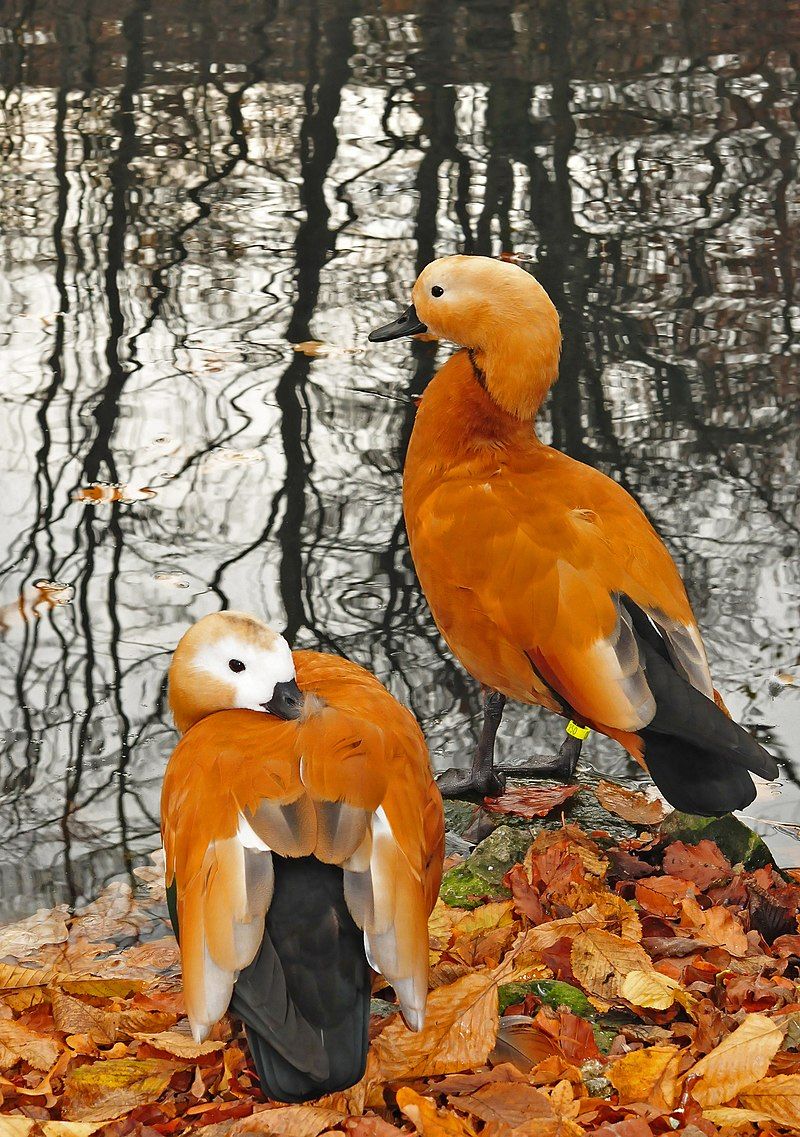
The ruddy shelduck, or Brahminy duck as it is known in India, is a member of the Anatidae family. It is a remarkable waterfowl, measuring between 58 and 70 centimeters in length and having a wingspan of 110 to 135 centimeters.
The striking coloration of the ruddy shelduck makes it stand out from other waterfowl in the area. It has reddish-brown feathering on its head, neck, and breast, and its wings are tipped with white feathers. Its bill is a deep yellow color and its legs are a shade of blue-grey.
The tail and back are a deep black color. The ruddy shelduck is found in wetlands, rivers, lakes, and other bodies of water in India, Central Asia, and the Middle East.
It feeds on aquatic plants, small fish, and other aquatic animals, and it uses its long neck to reach food along the lakebed. During the breeding season, it typically forms monogamous pairs and builds its nest in tree hollows or thick vegetation near water.
The female lays anywhere from five to ten eggs in the nest and then both parents take turns incubating them. The ruddy shelduck is a popular game bird in some parts of its range and is also hunted for its meat.
It is considered to be of least concern on the IUCN Red List and is a protected species in some countries.
| Kingdom | Animalia |
| Phylum | Chordata |
| Class | Aves |
| Order | Anseriformes |
| Family | Anatidae |
| Genus | Tadorna |
| Species | T. ferruginea |
17. Eurasian Coot
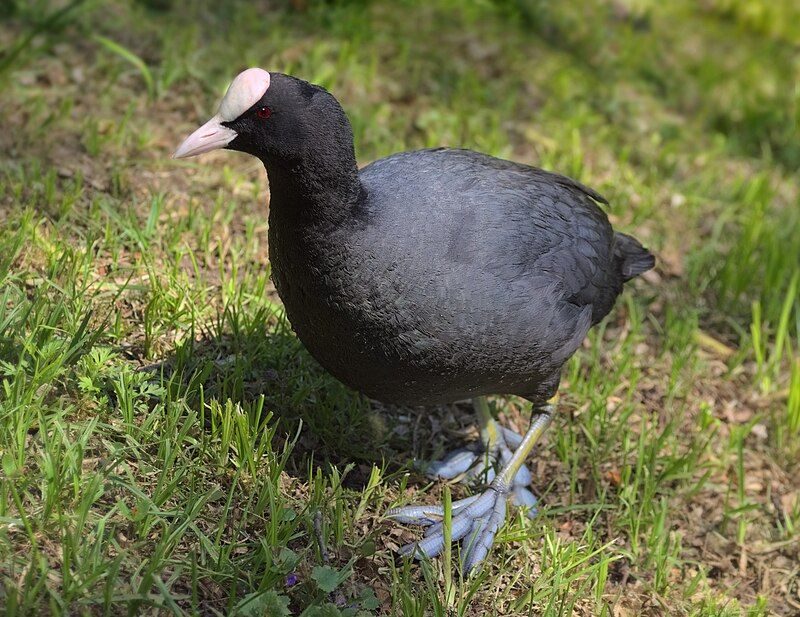
The Eurasian coot, also known as the common coot or Australian coot, is a water bird belonging to the family Rallidae. It is native to Europe, Asia, Australia, New Zealand, and parts of North Africa.
It has a distinctive black body with a glossy black head and a white bill with a white frontal shield. The Eurasian coot is a common sight near lakes and rivers, where it feeds on aquatic plants and small fish.
It also uses its white frontal shield to fend off predators, as it is a defence mechanism against predators. The Eurasian coot is a strong swimmer and can stay underwater for extended periods of time.
Its ability to stay underwater for longer periods of time has earned it the nickname “the diver bird”. The Eurasian coot is also known to form strong bonds with other members of its species and will often form large flocks when migrating.
The species is also popular among birdwatchers for its distinctive appearance and its ability to adapt to different environments.
| Kingdom | Animalia |
| Phylum | Chordata |
| Class | Aves |
| Order | Gruiformes |
| Family | Rallidae |
| Genus | Fulica |
| Species | F. atra |
18. Spotted Crake
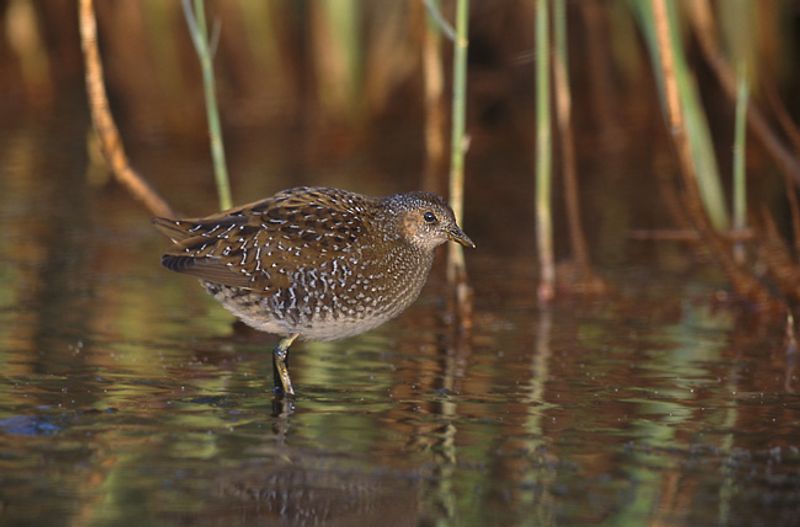
The spotted crake is a waterbird that belongs to the family Rallidae. Its scientific name is derived from Venetian terms that refer to small rails. This bird breeds in temperate regions of Europe and western Asia, in areas such as marshes and sedge beds.
Its nesting sites are located in dry places with marsh vegetation, and the female lays between 6 and 15 eggs. The spotted crake is a small bird, usually 15–18 cm long, and has a slim body and short yellow bill.
It has a black throat and head, and its upper parts are mottled brown and grey, while its underparts are white. Its wings have white and chestnut stripes.
It is usually seen in wetlands, where it feeds on small aquatic invertebrates and some vegetation. The spotted crake is a secretive bird, and is rarely seen or heard.
During breeding season, it is more active and can be heard making a distinctive call, described as “bob-bob-bob”, which is usually uttered during flight. It is a solitary species and generally avoids contact with other birds.
When disturbed, it will quickly fly away and hide in dense vegetation. The spotted crake is an endangered species, and its population has been declining due to loss of wetland habitats, pollution and predation.
Conservation efforts have been put in place to protect the species, such as restoring wetlands, reducing pollution and controlling predation. With these efforts, it is hoped that the spotted crake can be saved from extinction.
| Kingdom | Animalia |
| Phylum | Chordata |
| Class | Aves |
| Order | Gruiformes |
| Family | Rallidae |
| Genus | Porzana |
| Species | P. porzana |
19. Water Rail
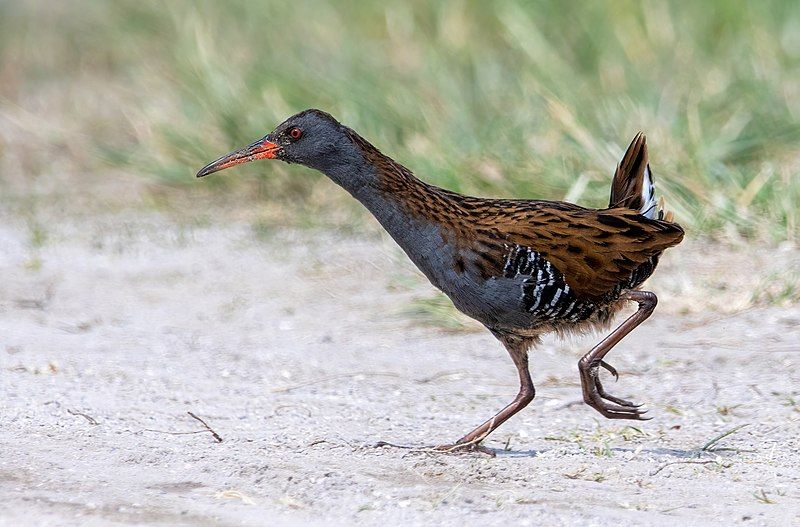
The water rail is a bird of the rail family, found in many regions of Europe, Asia, and North Africa. This species breeds in wetlands with abundant vegetation, and its behavior is influenced by the climate of its habitat.
In northern and eastern populations, the water rail is a migratory bird, travelling to warmer regions in the winter. However, in the warmer parts of its breeding range, it is a permanent resident, staying in the same area year-round.
The water rail’s ability to adapt to different climates and habitats allows it to have a wide geographic range, making it one of the most widespread rail species in the world.
| Kingdom | Animalia |
| Phylum | Chordata |
| Class | Aves |
| Order | Gruiformes |
| Family | Rallidae |
| Genus | Rallus |
| Species | R. aquaticus |
20. Common Scoter
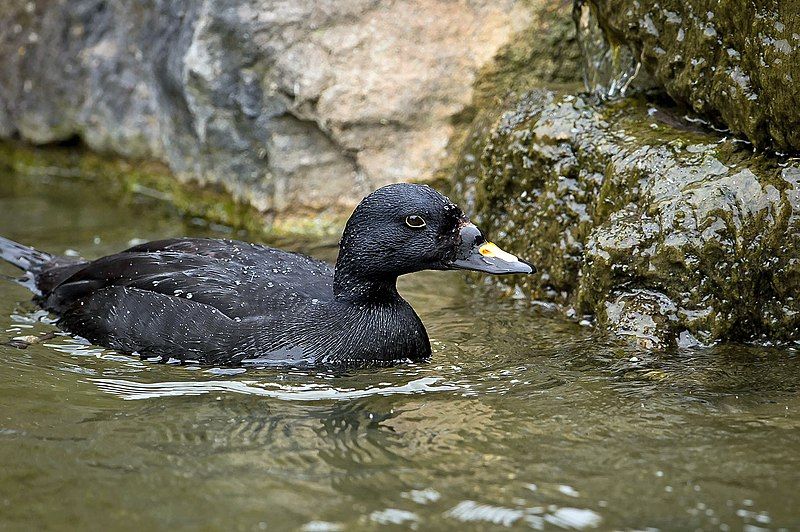
The Common Scoter is a large sea duck that is found in the far north of Europe and the Palearctic regions east to the Olenyok River. It is 43-54 cm in length and is characterized by its black color.
Its genus name, Melanitta, is derived from Ancient Greek words melas, which means “black”, and netta, which means “duck”. Its species name, niger, comes from Latin and means “shining black”. The Common Scoter is an important species of sea duck and is often hunted for its meat.
It has a wide distribution across the northern hemisphere and is an important part of the local ecology.
| Kingdom | Animalia |
| Phylum | Chordata |
| Class | Aves |
| Order | Anseriformes |
| Family | Anatidae |
| Genus | Melanitta |
| Species | M. nigra |
21. Ring-Necked Duck
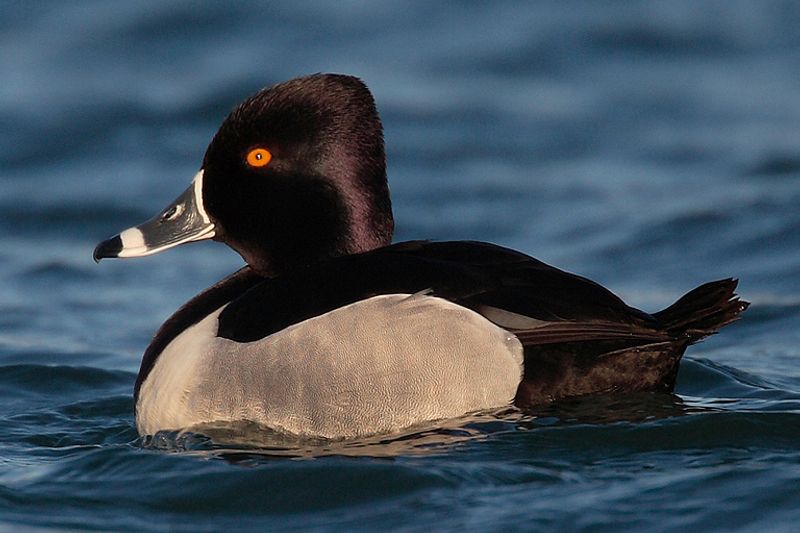
The Ring-necked duck is a type of waterfowl that is found in North America, typically inhabiting freshwater ponds and lakes. Its scientific name, Aythya collaris, is derived from two different languages.
In Greek, it is composed of the word Aithuia, which is an unidentified seabird referenced by authors such as Hesychius and Aristotle. The Latin part of its scientific name, collaris, literally translates to “of the neck” and is derived from the Latin word collum, meaning “neck”.
This is likely a reference to the distinct white ring found around the neck of the Ring-necked duck. The Ring-necked duck is a common sight in many freshwater bodies in North America, and it is an important part of the local wildlife and ecosystem.
| Kingdom | Animalia |
| Phylum | Chordata |
| Class | Aves |
| Order | Anseriformes |
| Family | Anatidae |
| Genus | Aythya |
| Species | A. collaris |
22. Brant
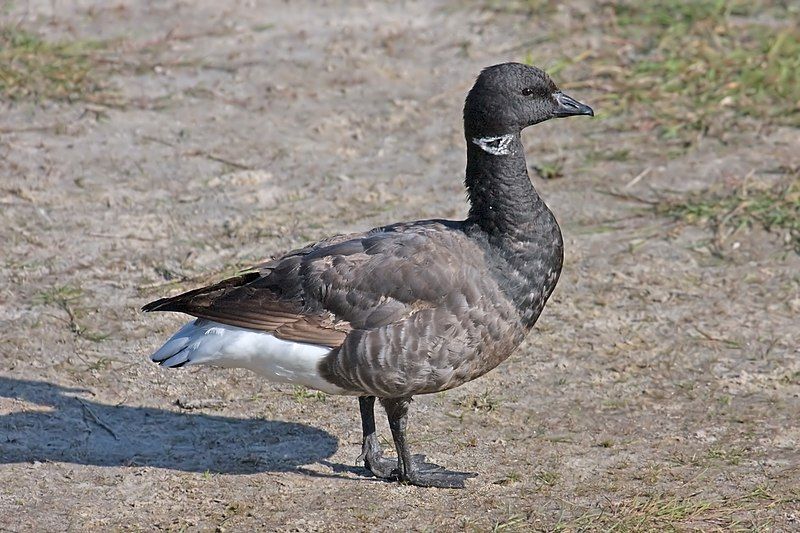
The brant or Brent goose is a species of small goose belonging to the genus Branta. They are generally found in coastal areas in temperate climates and breed on the tundra of the Arctic.
The three subspecies of the Brent goose are generally distinguished by their size and color. The Brent oilfield was named after the species, likely due to its abundance in the area.
The Brent goose is a migratory species and is a popular sight along the coasts of the UK, Ireland, Norway, and other parts of Europe. They are often seen in large flocks, and their distinctive white faces and black necks make them easily recognizable.
The Brent goose population is stable, and they are currently listed as a species of least concern on the IUCN Red List. They are also protected species in many countries, and hunting of the species is strictly regulated.
Overall, the Brent goose is a species that is easily recognizable and is an important part of many coastal ecosystems. It is also a reminder of how human activity can shape the environment, as it serves as a namesake for the Brent oilfield in the North Sea.
| Kingdom | Animalia |
| Phylum | Chordata |
| Class | Aves |
| Order | Anseriformes |
| Family | Anatidae |
| Genus | Branta |
| Species | B. bernicla |
23. Red-Breasted Goose
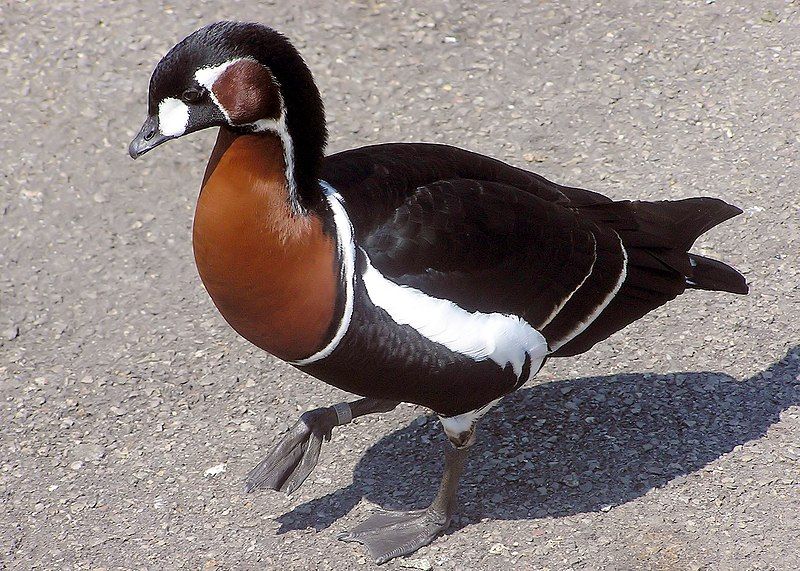
The red-breasted goose is a species of goose that is native to Eurasia and belongs to the genus Branta. It is easily identified by its bright red markings on its chest and wings.
According to the International Union for Conservation of Nature (IUCN), the red-breasted goose is classified as vulnerable.
This means that the species is facing a high risk of extinction in the near future. The red-breasted goose is a migratory species and is found in both the Palearctic and Nearctic regions.
It breeds in northern Europe and is known to travel as far as India and North Africa during the winter months. The red-breasted goose is a herbivore and feeds mainly on grasses and other plant material.
The IUCN notes that the population of the species has declined significantly due to hunting and the destruction of its wetland habitats. The population of the red-breasted goose is also threatened by the increasing presence of invasive species in its habitats.
Invasive species can outcompete native species for food and space, leading to a decrease in the population of the red-breasted goose.
Additionally, the species is also affected by the effects of climate change, with rising temperatures causing the loss of its wintering grounds. Conservation measures are being taken to help protect the red-breasted goose.
Conservationists are working to protect its wetland habitats and to reduce the amount of hunting that is taking place. Additionally, efforts are being made to reduce the effects of climate change and to create more suitable habitats for the species.
With these measures in place, it is hoped that the population of the red-breasted goose can be stabilized and its status can be improved.
| Kingdom | Animalia |
| Phylum | Chordata |
| Class | Aves |
| Order | Anseriformes |
| Family | Anatidae |
| Genus | Branta |
| Species | B. ruficollis |
24. Ruddy Duck
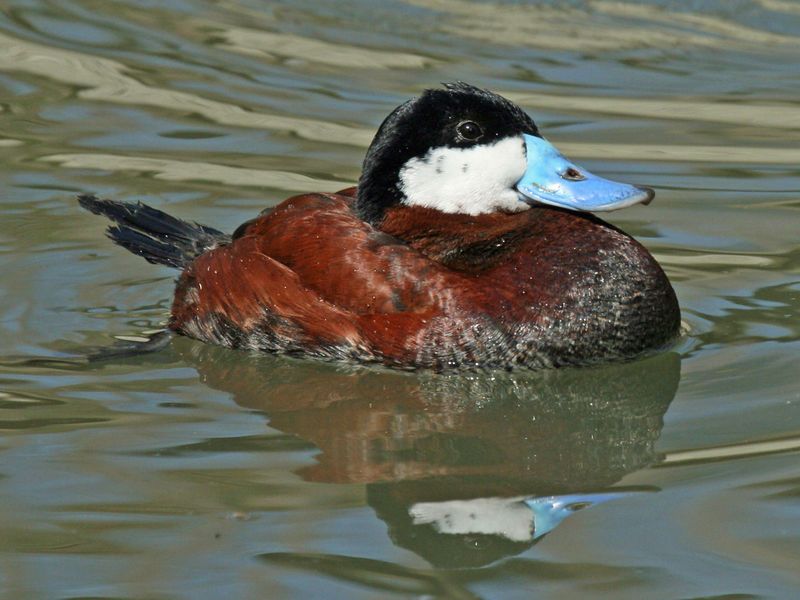
The ruddy duck is a North American duck belonging to the family of stiff-tailed ducks. It is named after its distinctive reddish-brown plumage. The genus name of this species is derived from the Ancient Greek oxus, meaning “sharp”, and oura, meaning “tail”.
The species name jamaicensis is derived from the fact that it was first documented in Jamaica. The ruddy duck is a small duck, measuring around 16 inches in length. It has distinctive rusty red-brown plumage, white cheeks, and a black cap.
The tail is stiff and pointed, and the bill is thin and pointed. The legs are short and blue-gray. The female is paler than the male, with a gray-brown body and white underparts.
The ruddy duck is found in marshes, ponds, and lakes, and feeds primarily on aquatic plants and insects. It breeds in shallow wetlands, and the nest is a shallow depression lined with vegetation. The female lays 5-6 eggs, which are incubated for 23-25 days.
The chicks are able to swim and dive soon after hatching. The ruddy duck is classified as a species of Least Concern by the International Union for Conservation of Nature.
It is hunted for sport, and its population is declining due to habitat destruction and competition with other species. However, conservation efforts are being made in some areas to protect this species.
| Kingdom | Animalia |
| Phylum | Chordata |
| Class | Aves |
| Order | Anseriformes |
| Family | Anatidae |
| Genus | Oxyura |
| Species | O. jamaicensis |
Conclusion
The birds of Limousin are an important part of the local ecology, providing food, shelter, and beauty for locals and tourists alike. They are a great source of education and enjoyment, and their presence in the region helps to keep the environment healthy and beautiful.
With careful conservation and protection, Limousin’s birds will continue to thrive for many years to come.